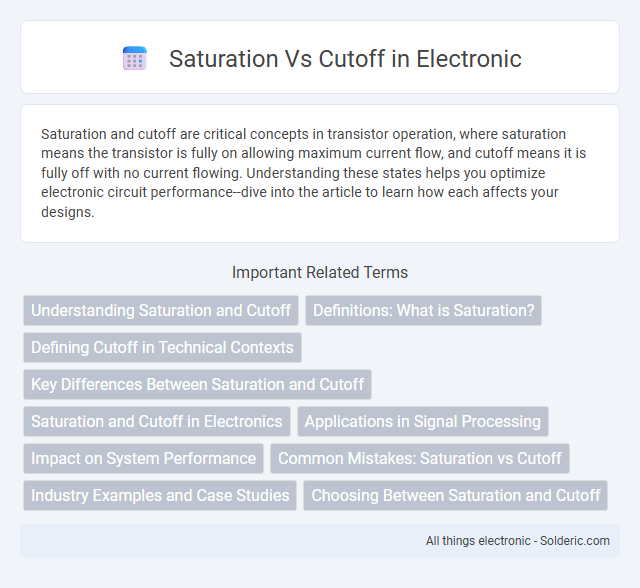Saturation and cutoff are critical concepts in transistor operation, where saturation means the transistor is fully on allowing maximum current flow, and cutoff means it is fully off with no current flowing. Understanding these states helps you optimize electronic circuit performance--dive into the article to learn how each affects your designs.
Comparison Table
| Parameter | Saturation | Cutoff |
|---|---|---|
| Definition | Condition where a device is fully on, allowing maximum current flow. | Condition where a device is fully off, blocking current flow. |
| Transistor Operation | Base-emitter junction and base-collector junction are forward biased. | Base-emitter junction is not forward biased; transistor is off. |
| Voltage Characteristics | Collector-emitter voltage (V_CE) is minimal (~0.2V). | Collector-emitter voltage (V_CE) is maximal, close to supply voltage. |
| Current Flow | Maximum collector current flows. | No or negligible collector current. |
| Application | Used for switching fully ON, saturation in switches and amplifiers. | Used for switching fully OFF, cutoff in digital circuits. |
Understanding Saturation and Cutoff
Saturation in electronics refers to the state where a transistor allows maximum current flow, acting as a closed switch, while cutoff indicates no current flow, functioning as an open switch. Understanding saturation and cutoff is essential for designing digital circuits, as these states enable binary on-off behavior. Accurate knowledge of these regions ensures optimal transistor switching, improving circuit efficiency and performance.
Definitions: What is Saturation?
Saturation in electronics refers to the state of a transistor when it is fully on, allowing maximum current to flow through from collector to emitter with minimal voltage drop. This condition indicates the transistor is operating as a closed switch, providing the highest possible output saturation current. Understanding saturation helps optimize your circuit's efficiency by ensuring it achieves maximum conductance without unnecessary power loss.
Defining Cutoff in Technical Contexts
Cutoff in technical contexts refers to the threshold at which a device or system ceases to operate or passes no current, often marking the boundary between active and inactive states. In transistors, the cutoff region means no conduction occurs, effectively turning the device off. This contrasts sharply with saturation, where the device operates at maximum conduction, allowing maximum current flow.
Key Differences Between Saturation and Cutoff
Saturation and cutoff are two distinct operating regions of a bipolar junction transistor (BJT), where saturation occurs when both the base-emitter and base-collector junctions are forward biased, allowing maximum current flow, and cutoff happens when both junctions are reverse biased, resulting in no current flow. In saturation, the transistor acts like a closed switch with minimal voltage drop across collector-emitter terminals, while in cutoff, it behaves as an open switch with no collector current. These differences are critical in digital circuits for switching applications, where saturation ensures full conduction and cutoff guarantees complete turn-off.
Saturation and Cutoff in Electronics
Saturation in electronics occurs when a transistor is fully on, allowing maximum current flow between collector and emitter, resulting in minimal voltage drop across the device. Cutoff is the opposite state, where the transistor is fully off, preventing current flow and acting as an open switch. These states are critical in digital circuits and switching applications, enabling transistors to function as efficient electronic switches or amplifiers.
Applications in Signal Processing
Saturation and cutoff play crucial roles in signal processing, particularly in amplifier design and dynamic range management. Saturation limits the maximum output signal amplitude, preventing distortion in analog circuits, while cutoff determines the threshold below which signals are attenuated or blocked, essential in filter design and noise reduction. Understanding these parameters helps optimize signal fidelity and prevent data loss in communication systems and audio processing applications.
Impact on System Performance
Saturation in electronic systems causes signal distortion by limiting the amplitude, leading to a reduction in signal clarity and potential data errors. Cutoff occurs when a transistor stops conducting, resulting in no current flow and potentially causing loss of signal or system shutdown. Understanding the impact of saturation versus cutoff on system performance helps optimize signal integrity and overall device efficiency for your applications.
Common Mistakes: Saturation vs Cutoff
Common mistakes between saturation and cutoff often arise from confusing their distinct roles in transistor operation. Saturation occurs when both the base-emitter and base-collector junctions are forward biased, resulting in maximum current flow, whereas cutoff is characterized by both junctions being reverse biased, leading to no current flow. Misinterpreting these states can cause design errors in amplifier circuits and switching applications, disrupting performance and reliability.
Industry Examples and Case Studies
Saturation and cutoff regions play critical roles in transistor applications across various industries, with saturation often utilized in switching devices for automotive control systems, while cutoff is essential in digital logic circuits within consumer electronics. In industrial automation, transistors operating in saturation enable reliable relay driving, whereas cutoff ensures low power consumption by effectively turning off the transistor. Case studies from power supply design highlight how managing these regions optimizes performance and reduces thermal stress, directly impacting your device's efficiency and longevity.
Choosing Between Saturation and Cutoff
Choosing between saturation and cutoff depends on the specific requirements of your transistor circuit, as saturation offers low voltage drop and efficient switching, while cutoff ensures complete transistor shutdown for minimal leakage current. Saturation mode is ideal for switching applications where the transistor acts like a closed switch, maximizing current flow, whereas cutoff mode is preferred when you need to prevent current flow entirely, acting like an open switch. Understanding the balance between these states enables precise control over your circuit's power efficiency and signal integrity.
Saturation vs Cutoff Infographic

 solderic.com
solderic.com